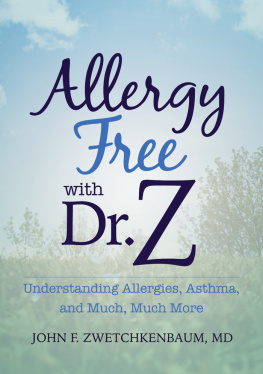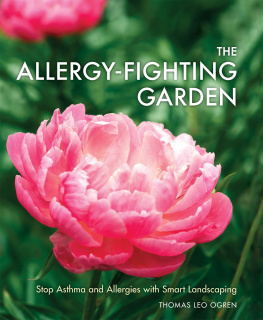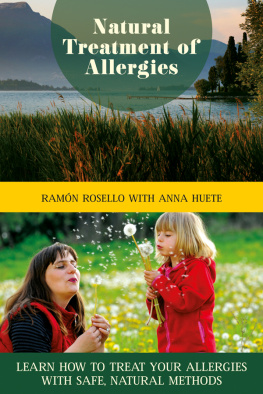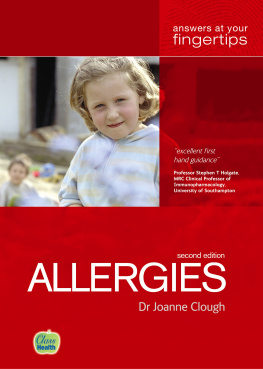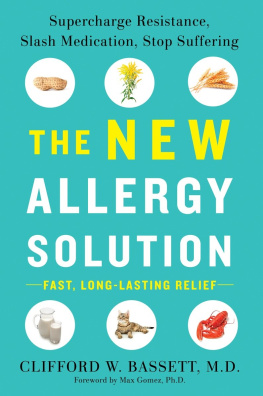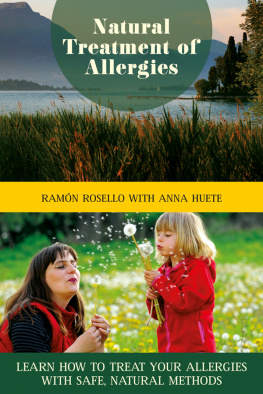Low-Pollen Petunia
Copyright 2015 by Thomas Leo Ogren
All rights reserved.
Published in the United States by Ten Speed Press, an imprint of the Crown Publishing Group,
a division of Random House LLC, a Penguin Random House Company, New York.
www.crownpublishing.com
www.tenspeed.com
Ten Speed Press and the Ten Speed Press colophon are registered trademarks of Random House LLC.
Much of this work is composed of material, revised and reworked, previously published in Allergy-Free Gardening , in 2000, and in Safe Sex in the Garden , in 2003, by Ten Speed Press, Berkeley.
Library of Congress Cataloging-in-Publication Data
Ogren, Thomas Leo.
The allergy-fighting garden : stop asthma and allergies with smart landscaping / Thomas Leo Ogren. First edition.
pages cm
Portions of this book were previously published in a different form in Allergy-Free Gardening in 2000 and in Safe Sex in the Garden in 2003.
Includes index.
1. Low-allergen gardens. 2. Low-allergen plants. 3. Plants, Sex in. I. Title.
SB433.4.O46 2015
635.9dc23
2014023777
Trade Paperback ISBN: 978-1-60774-491-7
eBook ISBN: 978-1-60774-492-4
Trade Paperback Design by Chloe Rawlins
All photographs by Thomas Leo Ogren, except for:
Front cover by ballycroy
(except second from top) by Ildiko Laszlo
by Lisa Regul
by Nigel Clarke
Illustrations by Shelby Stover
Illustration by Paquerette
v3.1
Aoenium
Alstroemeria sp.
Foreword
V ery rarely do we come across an idea that is both exceptionally good and revolutionary in its scope; the book The Allergy-Fighting Garden by Thomas Leo Ogren is such an idea.
I was a practicing allergist for more than fifty years. In the past I often advised people to avoid the toxic highly allergenic shrubs and trees, but my knowledge of botany was limited. Today, allergies are given short shrift in American medical schools. Students preparing for a medical career will receive only one or two lectures on the subject during a four-year course of intense study.
Allergies cause a huge amount of pain and suffering. There are many medical treatments for allergies, and none of them is perfect. All of them have side effects. The very best treatment for allergy is to avoid the offending substance. But when the state or city park department plants trees for shade, for example, they can end up causing intense suffering because of their poor choice of trees. Homeowners, too, unknowingly make poor choices and cause themselves years of allergy as they surround their houses with allergy-causing trees, shrubs, and lawns.
However, before this book, if you wanted to plant a landscape with allergy-free plants, you had few places to turn to for advice. Some landscapers knew that fruitless mulberries and olive trees caused allergy, but that was about it.
The Allergy-Fighting Garden is therefore a greatly needed book. Several things especially make this work so valuable. Ogrens allergy scale, assigning all plants a simple 1 to 10 allergy ranking, is a marvelous idea. All plants are not created equal. Certain plants cause no allergy, some cause very little, and some cause a great deal of suffering. Ogrens allergy scale addresses this problem head-on.
Another fine idea in this book is the reasoning about the dioecious species of plants. Dioecious (separate-sexed) plants cause far more than their share of allergies, because the male plants usually produce so much airborne pollen. These species, which include many common plants such as willows, ash, and maples, are often described as the worst allergy offenders. What Ogren figured out here is that the flip side is also true. If the males are the worst, then the females are the best! This is a simple idea, perhaps, but up until now no one has really addressed it.
The Allergy-Fighting Garden should be on the shelf of every serious gardener. All allergy specialists would be wise to own a copy, and certainly the book should be in the library of every nursery and municipal park department. Perhaps most important of all, this text should be required reading for every college student of landscape design or horticulture. Ogren has made a valuable contribution to our good health, and now it is up to us to put the information to work.
DAVID A. STADTNER, MD
Introduction
F or millions of people, allergies are no laughing matter. Allergies are not simply a bit of sneezing now and then; they are long days and nights of flat-out misery. Quite a few people have even died from severe reactions to allergenic pollen. In addition, there is now considerable data that demonstrate a powerful direct link between allergies and asthmaa very dangerous and often life-threatening condition. People with pollen allergies are more likely to develop food allergies and food intolerances. Pollen can cause rashes, sinus conditions, headaches, fatigue, irritability, and a number of other serious health problems that impact quality of life. It was recently reported in Lancet , a leading medical journal, that heart attack deaths rose 5 percent, heart disease deaths rose 6 percent, deaths from COPD (pulmonary/lung diseases) increased 15 percent, and pneumonia deaths jumped by 17 percent on days with peak pollen counts. The cost to the public in terms of drugs, doctors visits, hospital care, and lost school and work days is many billions of dollars, and it keeps increasing. But the other cost, in terms of human misery, is even more tragic, especially when much of this suffering could be avoided in the first place.
Although there are a variety of factors that can contribute to allergies, pollen is the most common allergen to which were exposed, and it is one that we can often control ourselves with the landscapes that surround our own houses, our schools, and the places where we work and play. I personally became involved in allergy-free gardening because my wife of forty-seven years, Yvonne, has asthma and allergies, and several times her asthma attacks almost killed her. Yvonnes asthma attacks occurred most often when her allergies were also at their worst, so when we bought a house in San Luis Obispo, California, I decided that I would re-landscape it so that nothing in our yard would trigger her allergies. First, I set out to buy some books on the subject, but found that there was nothing to buy. Because I had a background in horticulture, I began researching plants myself, one plant at a time, and in the process learned a great deal more about botany, medicine, pollen, and especially plant-flowering systems.




